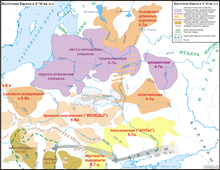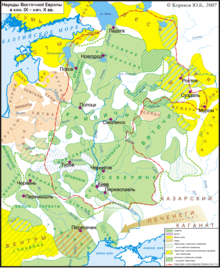
The Baltic languages are a branch of the Indo-European language family spoken natively or as a second language by a population of about 6.5–7.0 million people mainly in areas extending east and southeast of the Baltic Sea in Europe. Together with the Slavic languages, they form the Balto-Slavic branch of the Indo-European family.

The Balts or Baltic peoples are a group of peoples inhabiting the eastern coast of the Baltic Sea who speak Baltic languages. Among the Baltic peoples are modern-day Lithuanians and Latvians — all East Balts — as well as the Old Prussians, Curonians, Sudovians, Skalvians, Yotvingians and Galindians — the West Balts — whose languages and cultures are now extinct.
Sudovian was a West Baltic language of Northeastern Europe. Sudovian was closely related to Old Prussian. It was formerly spoken southwest of the Neman river in what is now Lithuania, east of Galindia and in the north of Yotvingia, and by exiles in East Prussia.
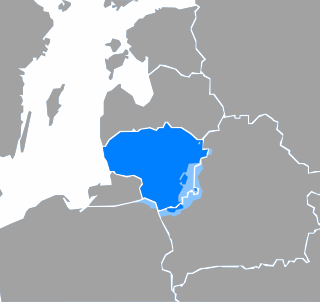
Lithuanian is an East Baltic language belonging to the Baltic branch of the Indo-European language family. It is the language of Lithuanians and the official language of Lithuania as well as one of the official languages of the European Union. There are approximately 2.8 million native Lithuanian speakers in Lithuania and about 1 million speakers elsewhere. Around half a million inhabitants of Lithuania of non-Lithuanian background speak Lithuanian daily as a second language.

The river Neris or Vilija rises in northern Belarus. It flows westward, passing through Vilnius and in the south-centre of that country it flows into the Nemunas (Neman) from the right bank, at Kaunas, as its main tributary. Its length is 510 km (320 mi).

Yotvingians were a Western Baltic people who were closely tied to the Old Prussians. The linguist Petras Būtėnas asserts that they were closest to the Lithuanians. The Yotvingians contributed to the formation of the Lithuanian state.

The Balto-Slavic languages form a branch of the Indo-European family of languages, traditionally comprising the Baltic and Slavic languages. Baltic and Slavic languages share several linguistic traits not found in any other Indo-European branch, which points to a period of common development and origin.

The Radimichs were an East Slavic tribe of the last several centuries of the 1st millennium, which inhabited upper east parts of the Dnieper down the Sozh and its tributaries. The name probably derives from the name of the forefather of the tribe - Radim. According to Russian chronicle tradition, "... but there were Radimichs from the Lechites family, who came and settled here and paid tribute to Rus, and the wagon was carried to the present day". However, in the scientific literature, there is no consensus on the ethnicity of the Radimichs. Archaeological evidence indicates that this tribal association had a mixed Slavic-Baltic origin.
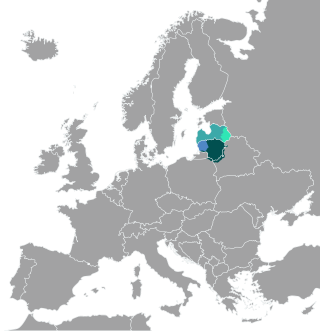
The East Baltic languages are a group of languages that along with the extinct West Baltic languages belong to the Baltic branch of the Indo-European language family. The East Baltic branch primarily consists of two extant languages—Latvian and Lithuanian. Occasionally, Latgalian and Samogitian are viewed as distinct languages, though they are traditionally regarded as dialects. It also includes now-extinct Selonian, Semigallian, and possibly Old Curonian.

Galindians were two distinct, and now extinct, tribes of the Balts. Most commonly, Galindians refers to the Western Galindians who lived in the southeast part of Prussia. Less commonly, it is used for a tribe that lived in the area of what is today Moscow.

The Nadruvians were a now-extinct Prussian tribe. They lived in Nadruvia, a large territory in northernmost Prussia. They bordered the Skalvians on the Neman (Nemunas) River just to the north, the Sudovians to the east, and other Prussian tribes to the south and west. Most information about the clan is provided in a chronicle by Peter von Dusburg.

The Zarubintsy, Zarubyntsi or Zarubinets culture was a culture that, from the 3rd century BC until the 1st century AD, flourished in the area north of the Black Sea along the upper and middle Dnieper and Pripyat Rivers, stretching west towards the Southern Bug river. Zarubintsy sites were particularly dense between the Rivers Desna and Ros as well as along the Pripyat river. It was identified around 1899 by the Czech-Ukrainian archaeologist Vikentiy Khvoyka and is now attested by about 500 sites. The culture was named after finds of cremated remains in the village of Zarubyntsi on the Dnieper.
Proto-Baltic is the unattested, reconstructed ancestral proto-language of all Baltic languages. It is not attested in writing, but has been partly reconstructed through the comparative method by gathering the collected data on attested Baltic and other Indo-European languages. It represents the common Baltic speech that approximately was spoken between the 3rd millennium BC and ca. 5th century BC, after which it began dividing into West and East Baltic languages. Proto-Baltic is thought to have been a fusional language and is associated with the Corded Ware and Trzciniec cultures.

The first known record of the name of Lithuania recorded in the Quedlinburg Chronicle in a 9 March 1009 story of Saint Bruno. The Chronicle recorded in the form Litua. Although it is clear the name originated from a Baltic language, scholars still debate the meaning of the word.

The Western Baltic culture was the westernmost branch of the Balts, representing a distinct archaeological culture of the Bronze Age and Iron Age, along the southern coast of the Baltic Sea. It is a zone of several small archaeological cultures that were ethnically Baltic and had similar cultural features. They included tribes such as the Old Prussians, Galindians, Yotvingians and Skalvians, in addition to the little-known Pomeranian Balts or Western Balts proper, in the area now known as Pomerania.

The West Baltic languages are a group of extinct Baltic languages that were spoken by West Baltic peoples. West Baltic is one of the two primary branches of Baltic languages, along with East Baltic. It includes Old Prussian, Sudovian, West Galindian, possibly Skalvian and Old Curonian.
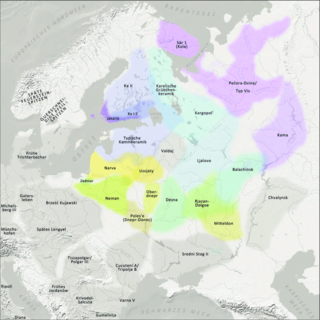
The archaeological Neman culture existed from about 5100 to the 3rd millennium BC, starting in the Mesolithic and continued into the middle Neolithic. It was located in the upper basin of the Neman River. In the north, the Neman culture bordered the Kunda culture during the Mesolithic and the Narva culture during the Neolithic.
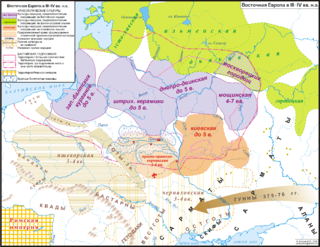
The Moshchiny culture (Russian: Мощинская культура) was an archaeological culture of the Iron Age from the 4th to the 7th century in present-day western Russia.


